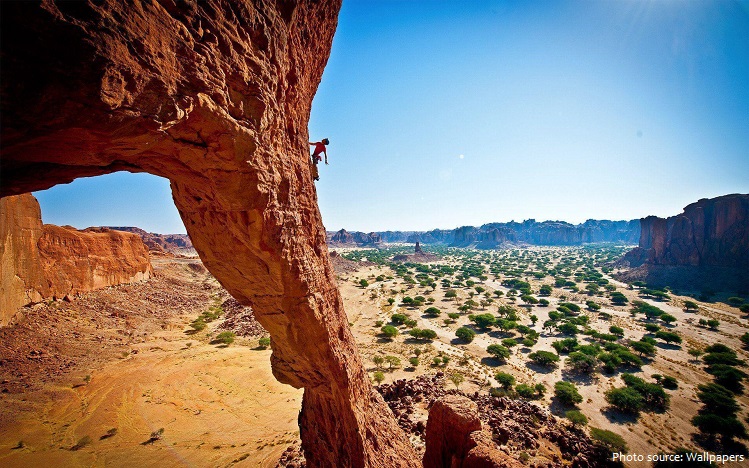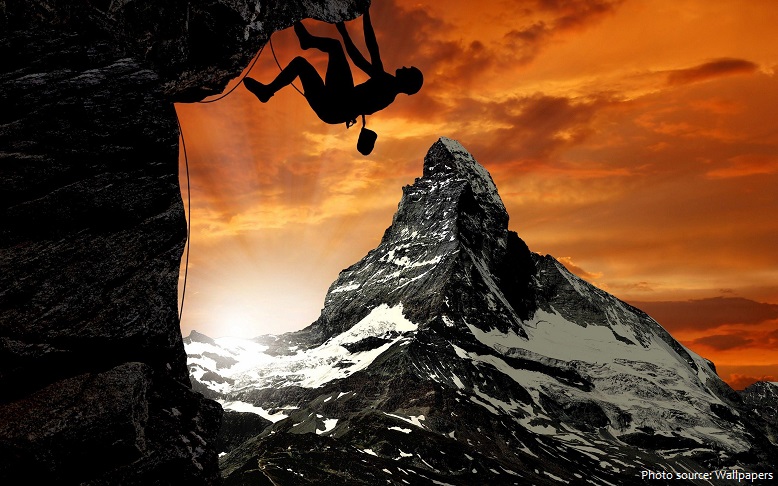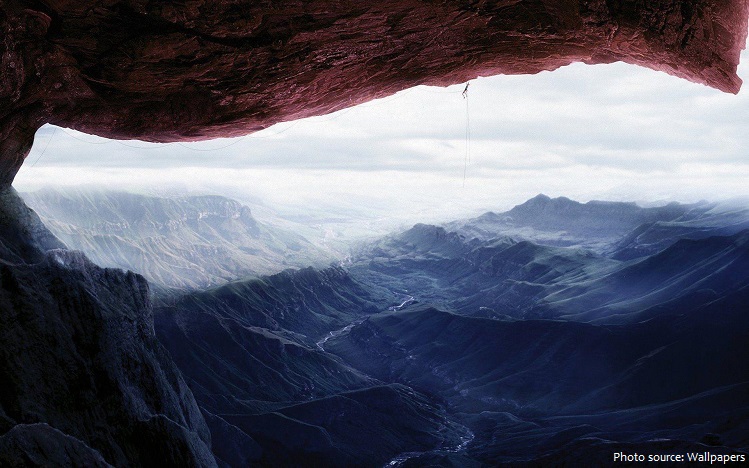
Rock climbing is a sport in which participants climb up, across, or down natural rock formations or artificial rock walls.
In rock climbing the essential equipment includes specialized shoes to provide extra grip on the rock surface, a harness to attach the ropes that will be used in the climb, and various types of anchors to be inserted into the rock face into which the ropes are secured or the climber’s body may be positioned. All climbers carry a chalk manufactured from magnesium carbonate, a chemical that dries a climber’s hands and fingers from the perspiration generated during a climb.
Success in rock climbing is achieved by reaching a particular summit or the endpoint of a pre-defined route without falling. In professional rock climbing competitions, participants are tested on the speed they complete a climbing route in or by achieving the farthest point on an increasingly difficult route.

Because of the wide range and variety of rock formations around the world, rock climbing has been separated into several different styles and sub-disciplines, such as scrambling, bouldering, sport climbing, and trad (traditional) climbing another activity involving the scaling of hills and similar formations, differentiated by the rock climber’s sustained use of hands to support their body weight as well as to provide balance.
Rock climbing was born out of the long tradition of mountaineering. It began with mountaineers needing to climb technical areas of rock in order to reach the summit. This led to mountaineers practicing technical climbing in more accessible areas. Eventually rock climbing began being viewed as a sport in it’s own right, rather than practice for mountaineering.

Although the practice of rock climbing was an important component of Victorian mountaineering in the Alps, it is generally thought that the sport of rock climbing began in the last quarter of the 19th century in at least three areas: Elbe Sandstone Mountains in Saxony near Dresden, the north of England including the Peak district and Lake District, and the Dolomites in Italy. Rock climbing evolved gradually from an alpine necessity to an athletic sport in its own right, making it imprudent to cite a primogenitor of the latter in each of these three locales.
Just before the First World War, there was a so-called “Mauerhakenstreit” in Central Europe regarding the use of aids in climbing and mountaineering. Paul Preuss and Hans Dülfer were the main actors in these discussions, which have essentially continued to this day. Preuss propagated a pure climbing style. Angelo Dibona, on the other hand, was an advocate of security and was not fundamentally averse to pitons. When Luis Trenker asked how many pitons he had hit in total in life, Dibona replied: “Fifteen, six of them on the Laliderer north face, three on the Ödstein, two on the Croz dell ‘Altissimo, one on the Einser and the rest on other difficult climbs.”

Throughout the first decades of the 20th century, the techniques and knowledge developed in early hotspots slowly traveled throughout North America, Europe, and elsewhere. This early era culminated in the 1930s, when many watershed technical climbs were done across Europe and North America, from the first ascent of Ship Rock in New Mexico and Devils Tower in Wyoming, to the Walker Spur of the Grandes Jorasses in the French Alps.
The first documented rock climber, however, did not climb for fun or fame, but rather to fulfil a royal command. In 1492, Antoine de Ville ascended Mont Inaccessible, a 300-meter tall rocky tower on Mont Aiguille near Grenoble, France on orders from King Charles VIII of France. Using techniques originally developed for the sieging of castles during wartime, de Ville used ladders and ropes to make it to Inaccessible’s summit, where they stayed for six days and erected three crosses to prove their ascent, which would not be repeated until 1834.

Bouldering, climbing without a rope on small cliffs and boulders where it is possible to land relatively safely, first evolved on the boulders of Fontainbleau outside of Paris in the mid-century. Because bouldering allows the climber to practice intricate movements unencumbered by a rope or safety concerns, it is the premier venue for pushing the absolute limits of free climbing.
Rock Climbing has exploded in popularity over the past century, especially since the 1980’s with the advent of the indoor climbing gym. According to the IFSCOpens in a new tab., 25 million people climb on a regular basis worldwide.
On August 3, 2016, the International Olympic Committee (IOC) formally announced that sport climbing would be a medal sport in the 2020 Summer Olympics.
